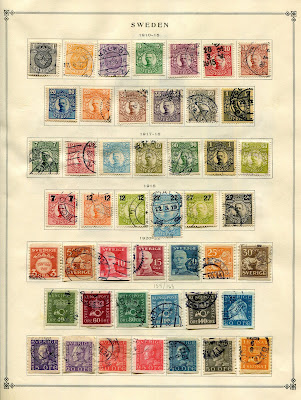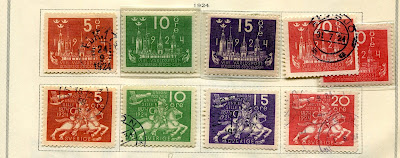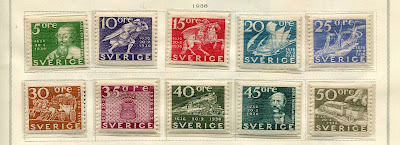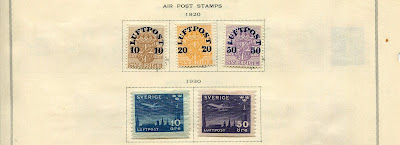Why? I recently bought a large Swedish collection on
Scott specialized pages. So, I refurbished my BB spaces and added stamps to the
supplement pages. New scans, seen below, show the results. Having done this, I’m
motivated to write about Sweden now rather than some months from now.
I’m often asked what I collect after having filled all
BB spaces. Short answer: I collect what BB omits. And that’s a lot of stamps.
What about Scott’s minor numbers? Stanley Gibbons catalogs
commonly list more major and minor numbers than Scott does. What about them? And
what about local stamps, interesting cancellations, postal stationery, covers,
anomalies, and the like? How can any collection ever be described as complete?
All are merely representative. Completeness is an obsession fueled nightmare.
Collecting all or most of
a country’s major stamp varieties, nevertheless, does represent a noteworthy
milestone. Completeness, even when approximate, tells a better story than blank
spaces can. When some form of completion happens in my collection, I put a new
header on my supplement pages, as seen atop Bud’s Big Blue Danish West Indies.
And I gussy up the pages with some additional information, the beginnings of
which can be seen in the Sweden supplements at the end of this post.
Nearing completion, however defined, presents some
problems and opportunities beyond the obvious question of what to do with
stamps that lack spaces. Take Sweden’s three numeral series (1877 thru 1889)
for example. BB provides twelve spaces for these, but each series has either ten
or eleven stamps. Moreover, BB’s spaces call for examples from all three
series.
I like to follow BB’s specs as nearly as I can, but I also want all stamps from a particular series placed together. My solution, admittedly less than ideal, puts the 1877-79 series in the album spaces, and the other two in the supplement pages. That arrangement will change if I get Sweden #18 or #37, two of the 30 that have eluded me.
My new Swedish acquisition also provided occasion for
rethinking postage dues. In the 19th century, these stamps were
affixed not only to internal mail that had insufficient postage, but also to
incoming international letters. Recipients had to pay to receive mail arriving
from beyond Sweden’s borders regardless of how much was paid by senders in
their home countries. Other nations followed this practice, too. If you’re
inclined to specialize in postage due stamps, Sweden is a great place to start.
The elaborately illustrated catalog of the Kersti and Bertil Larsson collection
of Swedish postal history has a large section about 19th century due
postage. It can be accessed online at: http://59b4eb31fe0806b35bcb5ee7cdf65d4eef4f9a4b-customer-media.s3.amazonaws.com/auctions/364/kataloge/Sweden.pdf.
Sweden issued two sets of
postage due stamps, 1874 and 1877. They differ in the number of perfs (first
14, then 13) and sight color shadings. (Sometime in the mid-1870s, Sweden’s
14-perf perforating machine must have broken down, and the replacement punched
holes at a rate of 13 per inch.) After both series were used up, stamp-fee
tickets were attached to underpaid correspondence. Below the amount of shortage,
the ticket reads “NOTE.! Upon delivery, the consignment will be stamped for the
redemption amount and the stamps will be canceled.”
The 1874 series is the scarcer;
most dues in my collection are of the 13-perf 1877 sort. BB permits examples drawn
from both series.
Adding to my batch of the
1924 Universal Postage Convention commemoratives has been the best part of
having a new influx of Swedish stamps. The fiftieth anniversary of the UPU was
being celebrated in Stockholm when these were issued.
I particularly like the
mail rider who, clutching his post horn, looks forlornly over his shoulder at a
ski equipped airplane – the minatory replacement for his mighty steed.
Census: 211 in BB spaces, 16 tip-ins, 180 on supplement pages.
Jim's Observations






















































Very nice. I have pulled my Sweden collection out of my Blue. I find them to be among the most beautiful. I really enjoy the two cancellations.
ReplyDelete